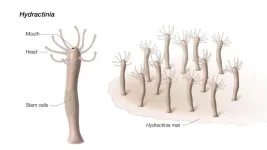(Press-News.org) How can you tell if a fruit fly is hungry? Ask a computer.
While that may sound like a bad dad joke, it’s reality at Tulane University, where researchers have developed a new A.I. tool that can tell you if a fruit fly is hungry, sleepy or singing (yes, fruit flies sing).
Dubbed MAFDA (for Novel Machine-learning-based Automatic Fly-behavioral Detection and Annotation) the system uses cameras and a newly developed software to track and identify complex interactive behaviors of individual flies within a larger group. This allows researchers to compare and contrast the behaviors of fruit flies with different genetic backgrounds.
For more than a century, scientists have used fruit flies’ simple genome and short lifespan to decode mysteries of inheritance and immunity in humans with studies of Drosophila melanogaster nabbing six Nobel Prizes. Fruit flies and humans share 60 percent of the same DNA.
Previous algorithms were less accurate at tracking individual flies within a group, but the MAFDA system makes studying the tiny, winged insects easier.
“Fruit flies are like pioneers in the discovery of new things, from the chromosome theory of inheritance to innate immunity,” said corresponding author Wu-Min Deng, PhD., professor of biochemistry and molecular biology and the Gerald & Flora Jo Mansfield Piltz Endowed Professor in Cancer Research at Tulane School of Medicine. “To be able to quantify the flies’ behavior is really a step forward in behavior studies.”
Wenkan Liu, a School of Medicine graduate student who developed the MAFDA system, said the significance of the platform is “undeniable.”
“It speeds up research, minimizes human error, and provides intricate insights into behavior genetics,” Liu said. “This tool is potentially pivotal as it enhances reproducibility and paves the way for new explorations in large-scale behavioral analysis.”
MAFDA was developed as part of a recent study, which discovered that the gene that causes flies to perceive pheromones is the same gene that controls pheromone production. These findings, published in Science Advances, challenge the status quo view that separate genes control pheromone production and perception and have broad applications in the fields of human behavioral evolution, metabolism and sex dimorphism.
Going forward, the researchers hope to see MAFDA used in a variety of applications. Jie Sun, lead author and postdoctoral fellow at Tulane School of Medicine, said MAFDA could eventually be used to study other insects as well as mice and fish, and the system may be useful in studying drug effects.
“The more information we give the machine, the better it gets at correctly identifying different behaviors from courtship to feeding and so on,” Sun said. “This is a very important, meaningful tool.”
MAFDA is already in use on other research projects at Tulane, and researchers are working to package the system so it can be used by more scientists both at Tulane and around the world .
“That’s the goal,” Deng said. “The original idea was to be able to identify the health status of flies. That may be too much to ask right now, but we’re hoping this will be more broadly used by the community and hopefully in the future we can go in that direction.”
END
New A.I. system can decode fruit fly behaviors. Why that’s ‘pivotal’ for future human genetics research
MAFDA automatically tracks fruit flies and compares individual behaviors with individual genotypes. Potential future applications include screening for drug effects and tracking behaviors of mice and fish.
2023-06-30
ELSE PRESS RELEASES FROM THIS DATE:
Breast cancer by age: Study reveals early mutations that predict patient outcomes
2023-06-30
LA JOLLA, CALIF. – June 30, 2023 – A study led by researchers at Sanford Burnham Prebys has found that in young women, certain genetic mutations are associated with treatment-resistant breast cancer. These mutations are not linked to treatment-resistant breast cancer in older women. The findings, published in the journal Science Advances, could help improve precision medicine and suggest a brand-new way of classifying breast cancer.
“It’s well established that as you get older, you’re more likely to develop cancer. But we’re finding that this may not be true for all cancers depending on a person’s genetic makeup,” ...
Displays controlled by flexible fins and liquid droplets more versatile, efficient than LED screens
2023-06-30
CHAMPAIGN, Ill. — Flexible displays that can change color, convey information and even send veiled messages via infrared radiation are now possible, thanks to new research from the University of Illinois Urbana-Champaign. Engineers inspired by the morphing skins of animals like chameleons and octopuses have developed capillary-controlled robotic flapping fins to create switchable optical and infrared light multipixel displays that are 1,000 times more energy efficient than light-emitting devices.
The new study led by mechanical science and engineering professor Sameh Tawfick demonstrates ...
CU Anschutz researchers identify unique cell receptor, potential for new therapies
2023-06-30
AURORA, Colo. (June 30, 2023) – Researchers from the University of Colorado Anschutz Medical Campus have identified a potential new immune checkpoint receptor that could lead to treatments for diseases such as lung and bowel cancer and autoimmune conditions including IBD.
The study, published today in Science Immunology, examines a family of 13 receptors, or proteins that transmit signals for cells to follow, called killer cell immunoglobulin-like receptors (KIR). Of the 13 receptors, one is unique in that it has not readily been observed on immune cells of ...
A new bacterial blueprint to aid in the war on antibiotic resistance
2023-06-30
A team of scientists from around the globe, including those from Trinity College Dublin, has gained high-res structural insights into a key bacterial enzyme, which may help chemists design new drugs to inhibit it and thus suppress disease-causing bacteria. Their work is important as fears continue to grow around rising rates of antibiotic resistance.
The scientists, led by Martin Caffrey, Fellow Emeritus in Trinity’s School of Medicine and School of Biochemistry and Immunology, used next-gen X-ray crystallography and single particle cryo-electron microscopy ...
Climate disasters, traumatic events have long-term impacts on youths' academics
2023-06-30
UNIVERSITY PARK, Pa. — Experiencing traumatic events such as natural disasters may have long-term consequences for the academic progress and future food security of youth — a problem researchers said could worsen with the increased frequency of extreme weather events due to climate change.
In a study using data from Peru, researchers from Penn State’s College of Agricultural Sciences found that being exposed to a greater number of traumatic events or “shocks,” such as a natural disaster or loss of family income, in early ...
Researchers demonstrate single-molecule electronic "switch" using ladder-like molecules
2023-06-30
Researchers have demonstrated a new material for single-molecule electronic switches, which can effectively vary current at the nanoscale in response to external stimuli. The material for this molecular switch has a unique structure created by locking a linear molecular backbone into a ladder-type structure. A new study finds that the ladder-type molecular structure greatly enhances the stability of the material, making it highly promising for use in single-molecule electronics applications.
Reported in the journal Chem, the study shows that the ladder-type molecule serves as a robust and reversible molecular switch over a wide range of conductivity levels and different molecular ...
Can bone-strengthening exercises and/or drugs reduce fracture risk when older adults lose weight?
2023-06-30
A $7 million study beginning this summer at Wake Forest University and Wake Forest University School of Medicine will help determine whether a combination of resistance training plus bone-strengthening exercises and/or osteoporosis medication use can help older adults safely lose weight without sacrificing bone mass.
That paradox – that shedding pounds can help stave off heart disease and diabetes while increasing bone loss and subsequent fracture risk – has been a focus of Wake Forest researcher Kristen Beavers for about a decade.
Her previous research ...
Incidence of diabetes in children and adolescents during the pandemic
2023-06-30
About The Study: Incidence rates of type 1 diabetes and diabetic ketoacidosis at diabetes onset in children and adolescents were higher after the start of the COVID-19 pandemic than before the pandemic. Increased resources and support may be needed for the growing number of children and adolescents with diabetes. Future studies are needed to assess whether this trend persists and may help elucidate possible underlying mechanisms to explain temporal changes.
Authors: Rayzel Shulman, M.D., ...
Association of preoperative high-intensity interval training with cardiorespiratory fitness, postoperative outcomes among adults undergoing major surgery
2023-06-30
About The Study: The results of this systematic review and meta-analysis of 12 studies including 832 patients suggest that preoperative high-intensity interval training may improve cardiorespiratory fitness and reduce postoperative complications. These findings support including high-intensity interval training in pre-habilitation programs before major surgery.
Authors: John C. Woodfield, Ph.D., of the University of Otago in Dunedin, New Zealand, is the corresponding author.
To access the embargoed study: Visit our For The Media ...
Scientists discover clues to aging and healing from a squishy sea creature
2023-06-30
Insights into healing and aging were discovered by National Institutes of Health researchers and their collaborators, who studied how a tiny sea creature regenerates an entire new body from only its mouth. The researchers sequenced RNA from Hydractinia symbiolongicarpus, a small, tube-shaped animal that lives on the shells of hermit crabs. Just as the Hydractinia were beginning to regenerate new bodies, the researchers detected a molecular signature associated with the biological process of aging, also known as senescence. According to the study published in Cell Reports, Hydractinia demonstrates that the fundamental biological processes of healing and aging are intertwined, ...
LAST 30 PRESS RELEASES:
Why are there so many Nordic mediators?
Young shark species more vulnerable to extinction
Mobile fetal heart monitoring linked to fewer newborn deaths in Tanzania
Bluey’s dad offered professorial chair in archaeology at Griffith University
Beyond small data limitations: Transfer learning-enabled framework for predicting mechanical properties of aluminum matrix composites
Unveiling non-thermal catalytic origin of direct current-promoted catalysis for energy-efficient transformation of greenhouse gases to valuable chemicals
Chronic breathlessness emerging as a hidden strain on hospitals
Paleontologists find first fossil bee nests made inside fossil bones
These fossils were the perfect home for ancient baby bees
Not everyone reads the room the same. A new study examines why.
New research identifies linked energy, immune and vascular changes in ME/CFS
Concurrent frailty + depression likely boost dementia risk in older people
Living in substandard housing linked to kids’ missed schooling and poor grades
Little awareness of medical + psychological complexities of steroid cream withdrawal
Eight in 10 trusts caring for emergency department patients in corridors, finds BMJ investigation
NASA’s Webb telescope finds bizarre atmosphere on a lemon-shaped exoplanet
The gut bacteria that put the brakes on weight gain in mice
Exploring how patients feel about AI transcription
Category ‘6’ tropical cyclone hot spots are growing
Video: Drivers struggle to multitask when using dashboard touch screens, study finds
SLU research shows surge in alcohol-related liver disease driving ‘deaths of despair’
Rising heat reshapes how microbes break down microplastics, new review finds
Roots reveal a hidden carbon pathway in maize plants
Membrane magic: FAMU-FSU researchers repurpose fuel cells membranes for new applications
UN Member States pledge to increase access to diagnosis and inhaled medicines for the 480 million people living with COPD
Combination therapy shows potential to treat pediatric brain cancer ATRT
Study links seabird nesting to shark turf wars in Hawai‘i
Legal sports betting linked to sharp increases in violent crime, study finds
Breakthrough AI from NYUAD speeds up discovery of life-supporting microbes
New Eva Mayr-Stihl Foundation funding initiative boosts research at University of Freiburg on adaptation of forests to global change
[Press-News.org] New A.I. system can decode fruit fly behaviors. Why that’s ‘pivotal’ for future human genetics researchMAFDA automatically tracks fruit flies and compares individual behaviors with individual genotypes. Potential future applications include screening for drug effects and tracking behaviors of mice and fish.


